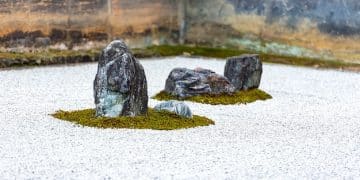Japanese wabi-sabi interior design tips for a serene space

Japanese wabi-sabi interior design tips focus on embracing imperfection, simplicity, and natural materials to create tranquil and meaningful living spaces that enhance well-being and foster mindfulness.
If you’ve ever felt drawn to the charm of imperfection, Japanese wabi-sabi interior design tips might resonate with you. This design philosophy embraces simplicity and natural beauty, encouraging a serene and harmonious living environment. Are you ready to discover how to transform your space?
Understanding the essence of wabi-sabi
Wabi-sabi is a captivating concept that reflects the beauty found in imperfection and the transient nature of life. By embracing this philosophy, we can create spaces that evoke serenity and mindfulness. Understanding the essence of wabi-sabi is key to incorporating it into our lives.
The core principles of wabi-sabi
The essence of wabi-sabi includes three main principles: impermanence, incompleteness, and imperfection. These ideas encourage you to appreciate the beauty that exists in flaws and the passage of time.
- Impermanence: Everything is constantly changing and nothing lasts forever.
- Incompleteness: Embrace the notion that a space or object doesn’t need to be finished to be beautiful.
- Imperfection: Celebrate the unique features that arise from wear and age.
This philosophy not only applies to design but also influences our daily lives. By welcoming wabi-sabi, you can cultivate patience and appreciation for the present moment.
Materials and elements that represent wabi-sabi
Incorporating materials that embody this aesthetic is essential. Natural materials, such as wood, stone, and clay, connect us to nature and remind us of life’s imperfections. Think about using handcrafted items that tell a story and evoke a sense of history.
When choosing colors, seek soft, muted tones that reflect simplicity and balance. Earthy hues can create a calm environment that resonates with the principles of wabi-sabi. Remember, it’s not about perfection; it’s about creating a space that feels authentic and welcoming.
Key elements in wabi-sabi design

Wabi-sabi design is all about appreciating the simple and imperfect. The key elements in wabi-sabi help create a harmonious and tranquil space that feels authentic and comfortable.
Natural materials
Using natural materials is fundamental in wabi-sabi design. Materials such as wood, stone, and clay bring warmth and connection to nature. They embody the raw beauty of imperfection.
- Wood: Look for reclaimed or weathered wood to add character.
- Stone: Use stones with unique textures and colors for a natural touch.
- Clay: Incorporate handmade pottery to emphasize craftsmanship.
These materials tell a story and help to ground the space in reality.
Earthy color palettes
Colors play a crucial role in conveying the wabi-sabi aesthetic. Earthy tones like browns, greens, and soft grays create a peaceful atmosphere. These colors encourage a calm mindset and allow your surroundings to feel inviting.
Using simple, muted colors fosters a sense of tranquility and balance. A color scheme that mirrors nature will enhance the overall feeling of your space.
With wabi-sabi, it’s essential to focus on simplicity and authenticity. This means allowing flaws to show and creating spaces that feel natural and lived in. Each element should invite connection and reflection.
Practical tips for incorporating wabi-sabi into your home
Incorporating wabi-sabi into your home is all about embracing simplicity and authenticity. It allows you to create a space that reflects your personality while celebrating imperfections. Here are some practical tips to get started.
Start with decluttering
The first step to achieving a wabi-sabi aesthetic is decluttering your space. Remove unnecessary items and keep only what you truly love. This not only creates more room but also helps in appreciating the objects that remain.
- Choose meaningful items: Select pieces that evoke memories or emotions.
- Embrace imperfections: Don’t shy away from items that show wear, as they add character.
- Keep it simple: Avoid overcrowding your space with decorations.
Once your space is decluttered, you can focus on the design elements.
Use natural textures
Incorporating natural textures is essential in achieving a wabi-sabi look. Textures can be created through materials like linen, cotton, wood, and stone. These elements bring a warm and organic feel to your home.
Consider mixing different textures to create depth. For example, pair rough wooden furniture with soft linen throws. This contrast highlights the beauty of imperfections and enhances the sensory experience of the space.
Another practical tip is to incorporate handmade items. Unique, handcrafted objects carry a story that mass-produced items simply don’t offer. These pieces serve as focal points in your home, showcasing individuality.
Incorporate plants and nature
Bringing nature indoors is a vital aspect of wabi-sabi. Incorporating plants not only purifies the air but also connects you to the outside world. Consider using simple, low-maintenance plants like succulents or ferns.
Choose containers that reflect natural materials. For instance, terracotta pots or simple clay vessels emphasize the organic feel you’re aiming for. The roughness of the materials will align perfectly with the wabi-sabi philosophy.
Incorporating these practical tips will help you create a wabi-sabi inspired home that feels inviting, serene, and true to your unique style. Remember, it’s about finding beauty in imperfection and enjoying the simplicity around you.
The benefits of a wabi-sabi inspired space

A wabi-sabi inspired space offers numerous benefits that enhance your well-being and overall mindset. This design philosophy encourages you to appreciate the beauty in imperfections and the transient nature of life.
Promotes tranquility
One of the primary benefits of wabi-sabi is the sense of tranquility it brings. Spaces designed with this philosophy often feature minimal clutter and calming colors, which can reduce stress and help you relax. Instead of feeling overwhelmed by excessive decorations, you can enjoy the simplicity and peace that comes from a thoughtfully curated space.
- Encourages mindfulness: A wabi-sabi environment fosters mindfulness, allowing you to appreciate the present moment.
- Creates a calming atmosphere: Natural materials and soft hues contribute to a soothing ambiance.
- Enhances focus: A simple space minimizes distractions, helping you concentrate better.
These elements combined create a soothing retreat where you can unwind.
Encourages creativity
A wabi-sabi inspired space can also spark creativity. The aesthetic encourages you to see beauty in the imperfect and the unusual. By surrounding yourself with unique, handcrafted items, you open your mind to new ideas and inspiration.
When you embrace imperfections, you are more likely to take risks and explore your creativity without the fear of judgment. This freedom can lead to innovative projects and artistic expression in your daily life.
Builds connection to nature
Incorporating natural elements into your home creates a deeper connection to the environment. Wabi-sabi emphasizes the beauty of the natural world, encouraging you to bring aspects of it indoors. This connection not only enhances the aesthetic but also promotes well-being.
Using plants, natural materials, and earthy colors grounds you in nature, which can improve your mood and mental health. Studies show that spending time in nature reduces stress and increases happiness. By creating a wabi-sabi space, you’re inviting those benefits into your everyday life.
Overall, embracing a wabi-sabi inspired space leads to a more fulfilling and balanced lifestyle. The focus on simplicity, natural beauty, and imperfection creates an environment that nourishes your mind and spirit.
FAQ – Frequently Asked Questions about Wabi-Sabi Design
What is wabi-sabi design?
Wabi-sabi design is a Japanese aesthetic that celebrates beauty in imperfection, simplicity, and the natural world.
How can I incorporate wabi-sabi into my home decor?
You can incorporate wabi-sabi by using natural materials, decluttering your space, and embracing handmade or imperfect items.
What are the benefits of a wabi-sabi inspired space?
A wabi-sabi space promotes tranquility, encourages creativity, enhances your connection to nature, and fosters mindfulness.
Can wabi-sabi design be applied to small spaces?
Yes, wabi-sabi design is versatile and can be effectively applied to small spaces by focusing on simplicity and meaningful items.





